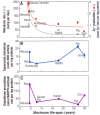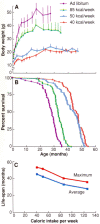Oxidative stress, caloric restriction, and aging
- PMID: 8658196
- PMCID: PMC2987625
- DOI: 10.1126/science.273.5271.59
Oxidative stress, caloric restriction, and aging
Abstract
Under normal physiological conditions, the use of oxygen by cells of aerobic organisms generates potentially deleterious reactive oxygen metabolites. A chronic state of oxidative stress exists in cells because of an imbalance between prooxidants and antioxidants. The amount of oxidative damage increases as an organism ages and is postulated to be a major causal factor of senescence. Support for this hypothesis includes the following observations: (i) Overexpression of antioxidative enzymes retards the age-related accrual of oxidative damage and extends the maximum life-span of transgenic Drosophila melanogaster. (ii) Variations in longevity among different species inversely correlate with the rates of mitochondrial generation of the superoxide anion radical (O2) and hydrogen peroxide. (iii) Restriction of caloric intake lowers steady-state levels of oxidative stress and damage, retards age-associated changes, and extends the maximum life-span in mammals.
Figures



Similar articles
-
Enhanced catabolism of mitochondrial superoxide/hydrogen peroxide and aging in transgenic Drosophila.Biochem J. 2005 Oct 15;391(Pt 2):277-84. doi: 10.1042/BJ20041872. Biochem J. 2005. PMID: 15954861 Free PMC article.
-
Mitochondrial superoxide and hydrogen peroxide generation, protein oxidative damage, and longevity in different species of flies.Free Radic Biol Med. 1995 Oct;19(4):499-504. doi: 10.1016/0891-5849(95)00037-x. Free Radic Biol Med. 1995. PMID: 7590400
-
Simultaneous overexpression of copper- and zinc-containing superoxide dismutase and catalase retards age-related oxidative damage and increases metabolic potential in Drosophila melanogaster.J Biol Chem. 1995 Jun 30;270(26):15671-4. doi: 10.1074/jbc.270.26.15671. J Biol Chem. 1995. PMID: 7797567
-
Caloric restriction and the aging process: a critique.Free Radic Biol Med. 2014 Aug;73:366-82. doi: 10.1016/j.freeradbiomed.2014.05.015. Epub 2014 Jun 2. Free Radic Biol Med. 2014. PMID: 24941891 Free PMC article. Review.
-
Oxidative Stress and the Aging Brain: From Theory to Prevention.In: Riddle DR, editor. Brain Aging: Models, Methods, and Mechanisms. Boca Raton (FL): CRC Press/Taylor & Francis; 2007. Chapter 15. In: Riddle DR, editor. Brain Aging: Models, Methods, and Mechanisms. Boca Raton (FL): CRC Press/Taylor & Francis; 2007. Chapter 15. PMID: 21204345 Free Books & Documents. Review.
Cited by
-
Interaction of Cooking-Generated Aerosols on the Human Nervous System and the Impact of Caloric Restriction Post-Exposure.Nutrients. 2024 Oct 17;16(20):3525. doi: 10.3390/nu16203525. Nutrients. 2024. PMID: 39458519 Free PMC article.
-
The Double-Edged Sword of Total Antioxidant Capacity: Clinical Significance and Personal Experience.Antioxidants (Basel). 2024 Aug 1;13(8):933. doi: 10.3390/antiox13080933. Antioxidants (Basel). 2024. PMID: 39199179 Free PMC article. Review.
-
Health Benefits of Intermittent Fasting.Microb Physiol. 2024;34(1):142-152. doi: 10.1159/000540068. Epub 2024 Jul 2. Microb Physiol. 2024. PMID: 38955141 Review.
-
Effects of ibuprofen in the ZDF rat model of type 2 diabetes.J Food Drug Anal. 2024 Jun 15;32(2):227-238. doi: 10.38212/2224-6614.3506. J Food Drug Anal. 2024. PMID: 38934691 Free PMC article.
-
Decreasing Intracellular Entropy by Increasing Mitochondrial Efficiency and Reducing ROS Formation-The Effect on the Ageing Process and Age-Related Damage.Int J Mol Sci. 2024 Jun 7;25(12):6321. doi: 10.3390/ijms25126321. Int J Mol Sci. 2024. PMID: 38928027 Free PMC article. Review.
References
Publication types
MeSH terms
Substances
Grants and funding
LinkOut - more resources
Full Text Sources
Other Literature Sources
Medical
Molecular Biology Databases

